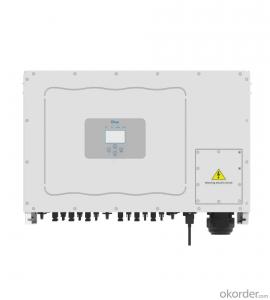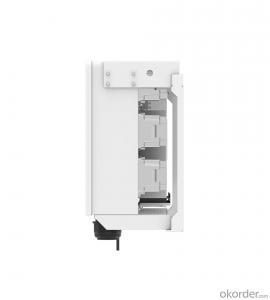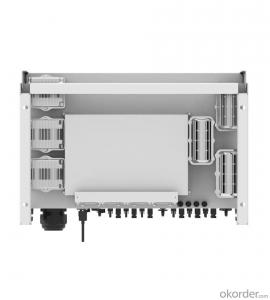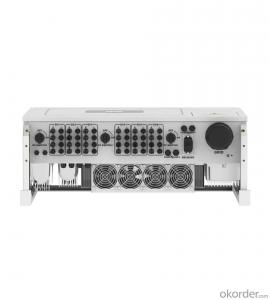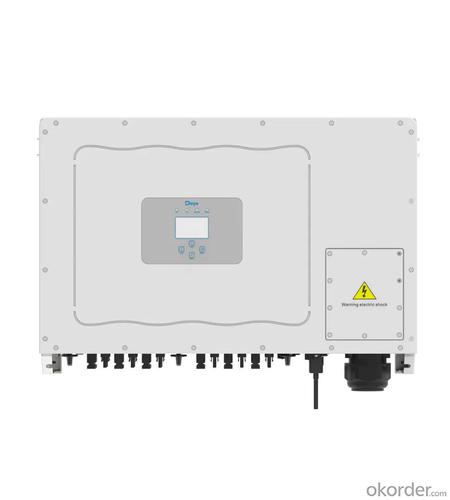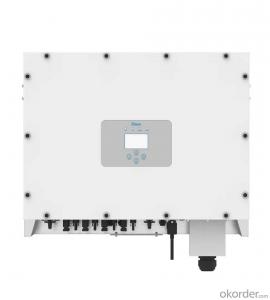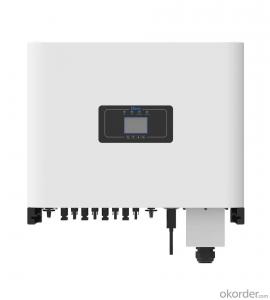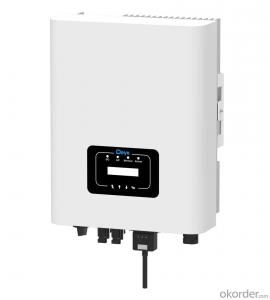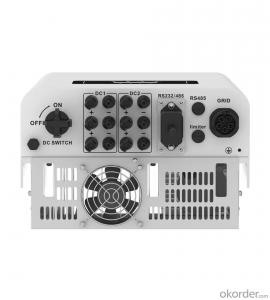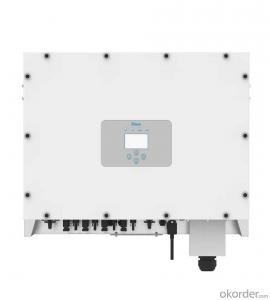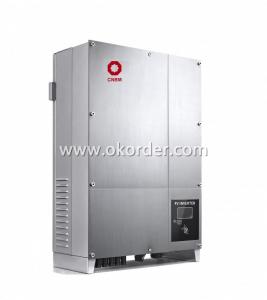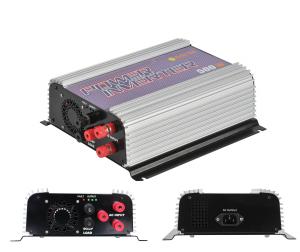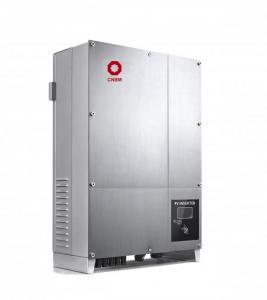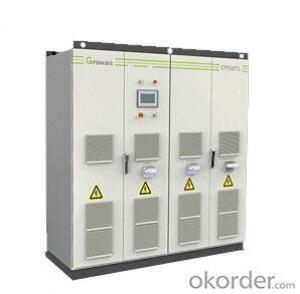Commercial Solar Inverter - sun70/75/80/90/100/110k-g03 | 70-110kw | Three Phase | 6 MPPT
- Loading Port:
- Ningbo
- Payment Terms:
- TT OR LC
- Min Order Qty:
- 100 pc
- Supply Capability:
- 5000 pc/month
OKorder Service Pledge
OKorder Financial Service
You Might Also Like
Specification
The Deye 70-110K grid-connected inverter is suited for medium and large-scale commercial rooftops and ground-mounted solar PV system in which reliability and stability are important. the full series inverter has 30% DC input oversizing ratio and 10% AC output overloading ratio, offering a faster return on investment.
Max. 6 MPP trackers, Max. efficiency up to 98.7%
Zero export application, VSG application
String intelligent monitoring (optional)
Wide output voltage range
Type II DC/AC SPD
Anti-PID function (Optional)
| Model | SUN-70K-G03 | SUN-75K-G03 | SUN-80K-G03 | SUN-90K-G03 | SUN-100K-G03 | SUN-110K-G03 | ||
| Input Side | ||||||||
| Max. DC Input Power (kW) | 91 | 97.5 | 104 | 135 | 150 | 150 | ||
| Max. DC Input Voltage (V) | 1000 | |||||||
| Start-up DC Input Voltage (V) | 250 | |||||||
| MPPT Operating Range (V) | 200~850 | |||||||
| Max. DC Input Current (A) | 40+40+40+40 | 40+40+40+40+40+40 | ||||||
| Max. Short Circuit Current (A) | 60+60+60+60 | 60+60+60+60+60+60 | ||||||
| Number of MPPT / Strings per MPPT | 4/4 | 6/4 | ||||||
| Output Side | ||||||||
| Rated Output Power (kW) | 70 | 75 | 80 | 90 | 100 | 110 | ||
| Max. Active Power (kW) | 77 | 82.5 | 88 | 99 | 110 | 121 | ||
| Nominal Output Voltage / Range (V) | 3L/N/PE 380V/0.85Un-1.1Un, 400V/0.85Un-1.1Un | |||||||
| Rated Grid Frequency (Hz) | 50 / 60 (Optional) | |||||||
| Operating Phase | Three phase | |||||||
| Rated AC Grid Output Current (A) | 101.5 | 108.7 | 115.9 | 130.4 | 144.9 | 159.4 | ||
| Max. AC Output Current (A) | 111.6 | 119.6 | 127.5 | 143.5 | 159.4 | 175.4 | ||
| Output Power Factor | >0.99 | |||||||
| Grid Current THD | <3% | |||||||
| DC Injection Current (mA) | <0.5% | |||||||
| Grid Frequency Range | 47~52 or 57~62 (Optional) | |||||||
| Efficiency | ||||||||
| Max. Efficiency | 98.7% | |||||||
| Euro Efficiency | 98.3% | |||||||
| MPPT Efficiency | >99% | |||||||
| Protection | ||||||||
| DC Reverse-Polarity Protection | Yes | |||||||
| AC Short Circuit Protection | Yes | |||||||
| AC Output Overcurrent Protection | Yes | |||||||
| Output Overvoltage Protection | Yes | |||||||
| Insulation Resistance Protection | Yes | |||||||
| Ground Fault Monitoring | Yes | |||||||
| Anti-islanding Protection | Yes | |||||||
| Temperature Protection | Yes | |||||||
| Integrated DC Switch | Yes | |||||||
| Remote software upload | Yes | |||||||
| Remote change of operating parameters | Yes | |||||||
| Surge protection | DC Type II / AC Type II | |||||||
| General Data | ||||||||
| Size (mm) | 838W×568H×323D | |||||||
| Weight (kg) | 73.7 | |||||||
| Topology | Transformerless | |||||||
| Internal Consumption | <1W (Night) | |||||||
| Running Temperature | -25~65℃, >45℃ derating | |||||||
| Ingress Protection | IP65 | |||||||
| Noise Emission (Typical) | <55 dB | |||||||
| Cooling Concept | Smart cooling | |||||||
| Max. Operating Altitude Without Derating | 2000m | |||||||
| Warranty | 5 years | |||||||
| Grid Connection Standard | CEI 0-21, VDE-AR-N 4105, NRS 097, IEC 62116, IEC 61727, G99, G98, VDE 0126-1-1, RD 1699, C10-11 | |||||||
| Operating Surroundings Humidity | 0-100% | |||||||
| Safety EMC / Standard | IEC/EN 61000-6-1/2/3/4, IEC/EN 62109-1, IEC/EN 62109-2 | |||||||
| Features | ||||||||
| DC Connection | MC-4 mateable | |||||||
| AC Connection | IP65 rated plug | |||||||
| Display | LCD 240 × 160 | |||||||
| Interface | RS485/RS232/Wifi/LAN | |||||||
- Q: How does a solar inverter handle power quality disturbances?
- A solar inverter handles power quality disturbances by monitoring the incoming power from the solar panels and adjusting its output accordingly. It uses various control mechanisms to regulate voltage and frequency, ensuring that the power generated by the solar panels is synchronized with the grid. This helps in maintaining a stable and high-quality power supply, minimizing the impact of disturbances such as voltage fluctuations or frequency variations. Additionally, some advanced solar inverters also offer features like grid support functions and reactive power compensation to further enhance power quality.
- Q: Can a solar inverter be used with a solar-powered EV charging network?
- Yes, a solar inverter can be used with a solar-powered EV charging network. A solar inverter is responsible for converting the direct current (DC) produced by solar panels into alternating current (AC) that can be used to power electrical devices, including EV chargers. By integrating a solar inverter into a solar-powered EV charging network, the energy generated by the solar panels can directly power the charging stations, reducing reliance on the grid and promoting sustainable energy use.
- Q: Can a solar inverter be used with solar trackers?
- Yes, a solar inverter can be used with solar trackers. Solar trackers are used to maximize the efficiency of solar panels by orienting them towards the sun. Solar inverters are responsible for converting the DC power generated by solar panels into usable AC power. Both components work together to optimize solar energy production.
- Q: Can a solar inverter be used with battery storage?
- Yes, a solar inverter can be used with battery storage. In fact, integrating a solar inverter with battery storage systems allows for storing excess solar energy generated during the day and using it at night or during times of high energy demand. This combination enables greater energy independence and the ability to use renewable energy even when the sun is not shining.
- Q: What is the role of voltage regulation in a solar inverter?
- The role of voltage regulation in a solar inverter is to ensure that the output voltage of the inverter remains stable and within a certain range, regardless of fluctuations in the input voltage from the solar panels. This is important as it allows the inverter to effectively convert the DC power generated by the solar panels into AC power that can be used by household appliances or fed back into the grid. Voltage regulation helps protect the connected devices from voltage spikes or drops, optimizes the performance of the inverter, and ensures the safe and efficient operation of the entire solar power system.
- Q: What are the safety features in a solar inverter?
- Playing a crucial role in the conversion of direct current (DC) electricity from solar panels to alternating current (AC) electricity, solar inverters, also known as photovoltaic (PV) inverters, are equipped with various safety features to ensure their safe and efficient operation. Among the primary safety features of a solar inverter is ground fault protection. This feature is designed to detect any leakage of current to the ground, which may indicate a fault in the system. If a ground fault is detected, the inverter will immediately shut down to prevent potential electrocution hazards. To safeguard against overvoltage situations, solar inverters are equipped with surge protection devices (SPDs). These devices divert excessive voltage spikes or surges to the earth, thereby protecting the inverter and other connected electrical equipment from damage. In the event of a grid power outage or blackout, solar inverters have anti-islanding protection. This feature ensures that the inverter automatically disconnects from the grid, preventing power backfeeding, which could pose a serious threat to utility workers attempting to repair the grid. Temperature monitoring is another crucial safety feature in solar inverters. With the potential for heat generation during operation, inverters are equipped with temperature sensors to monitor internal temperature. If the temperature exceeds the safe limit, the inverter will automatically shut down to prevent potential fire hazards. Additionally, solar inverters often incorporate built-in arc fault circuit interrupters (AFCIs). These devices are designed to detect and interrupt dangerous arc faults that may occur due to damaged or deteriorating wiring connections. By promptly stopping the flow of electricity, AFCIs help prevent electrical fires. Lastly, many solar inverters feature advanced monitoring and diagnostic systems. These systems provide real-time data and alerts, enabling users or installers to promptly identify and address potential safety issues. In conclusion, the safety features in a solar inverter are essential for ensuring the secure and reliable operation of the system. These features protect against electrical hazards, prevent damage to the inverter and connected equipment, and contribute to the overall safety of the solar power generation system.
- Q: Can a solar inverter be used in conjunction with a power optimizer?
- Yes, a solar inverter can be used in conjunction with a power optimizer. In fact, this combination is commonly used in solar power systems to optimize energy production. The power optimizer helps maximize the performance of each individual solar panel by adjusting the voltage and current levels, while the solar inverter converts the DC electricity produced by the panels into usable AC electricity for the grid. Together, they enhance the overall efficiency and output of the solar system.
- Q: What are the key factors affecting the installation process of a solar inverter?
- There are several key factors that can affect the installation process of a solar inverter. Some of these factors include the location and orientation of the solar panels, the distance between the panels and the inverter, the type and capacity of the inverter, the wiring and electrical connections, and the availability of appropriate mounting structures. Additionally, factors such as local regulations, building codes, and safety considerations also play a crucial role in the installation process of a solar inverter.
- Q: What is the role of a solar inverter in a battery storage system?
- The role of a solar inverter in a battery storage system is to convert the direct current (DC) electricity produced by the solar panels into alternating current (AC) electricity, which is compatible with the electrical grid and can be used to power household appliances or feed back into the grid. Additionally, the solar inverter manages the charging and discharging of the batteries, ensuring efficient energy storage and usage.
- Q: Can a solar inverter be used with different types of communication interfaces?
- Yes, a solar inverter can be used with different types of communication interfaces. Many modern solar inverters are designed to be compatible with various communication protocols such as Wi-Fi, Ethernet, RS485, and Zigbee. This allows for easy integration and monitoring of the inverter with different types of communication systems and devices.
Send your message to us
Commercial Solar Inverter - sun70/75/80/90/100/110k-g03 | 70-110kw | Three Phase | 6 MPPT
- Loading Port:
- Ningbo
- Payment Terms:
- TT OR LC
- Min Order Qty:
- 100 pc
- Supply Capability:
- 5000 pc/month
OKorder Service Pledge
OKorder Financial Service
Similar products
Hot products
Hot Searches
Related keywords
